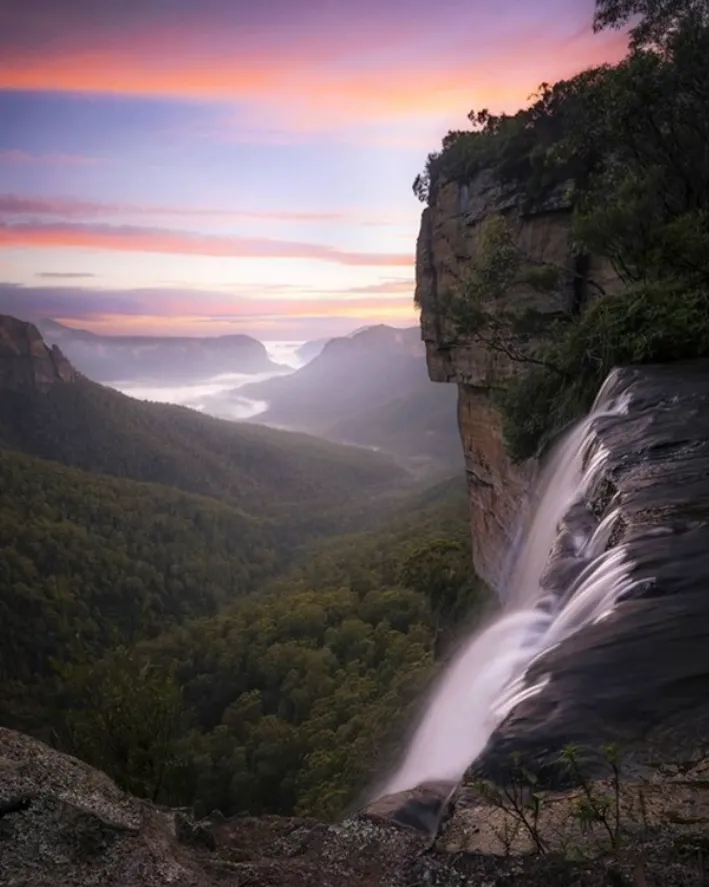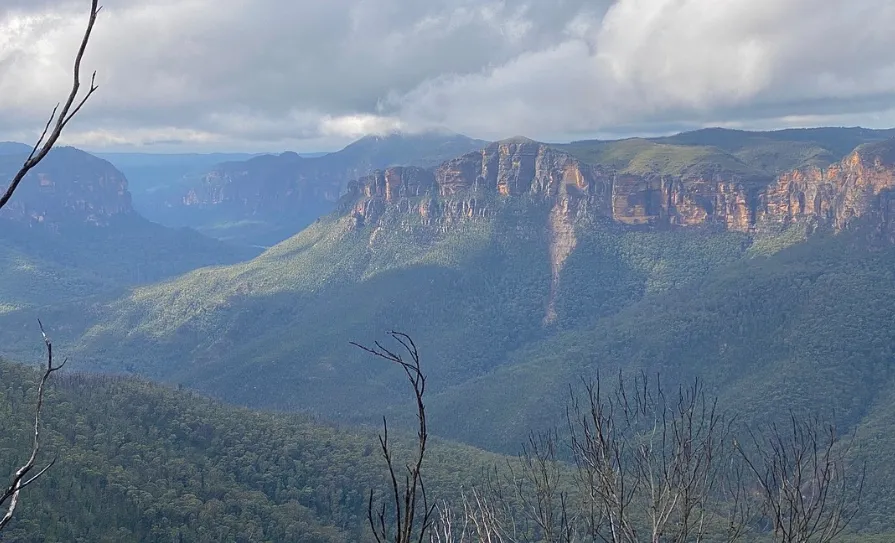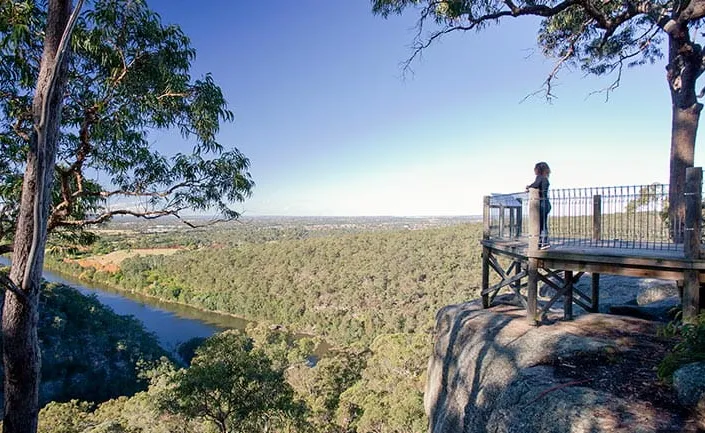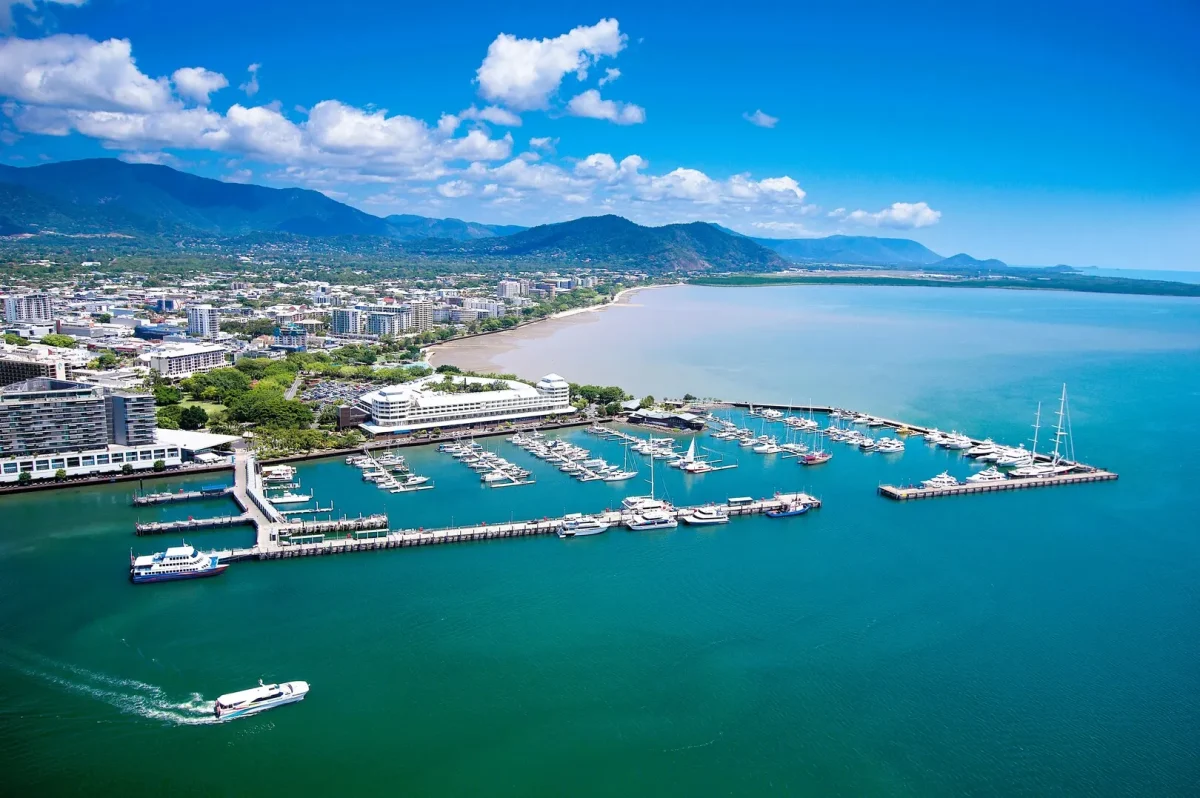
Blue Mountains National Park
Spread over 260,000 hectares and part of the UNESCO Great Blue Mountains World Heritage Site; the Blue Mountains National Park is the most visited national Park in New South Wales.
Don’t miss out on a Blue Mountains tour! Visit scenic lookouts, hike through lush forests, and encounter native wildlife on this unforgettable adventure.
Grand Blue Mountains World Heritage Park
The Great Blue Mountains National Park in Katoomba is a UNESCO World Heritage site known for its iconic Three Sisters rock formation. Discover iconic landscapes and amazing waterfalls, popular trails, mountain biking, Aboriginal culture, adventure sports, and camping trails in Sydney. The Sydney Heritage Centre extensively introduces this famous Park and the UNESCO World Heritage Greater Blue Mountains.
After packing a picnic lunch, go to Echo Point in Katoomba for a day excursion to visit the Three Sisters rock formation. From Govetts Leap in Blackheath, enjoy incredible views of sheer sandstone cliffs and the misty blue Grose Valley, a designated conservation area.
At Wentworth Falls, you’ll find world-class viewing platforms. World-class viewing platforms, walks and stunning waterfalls surround you. Would you like to push yourself to hike the 19km Grand Cliff Top Walk in two days, starting in Wentworth Falls and ending in Katoomba?


Thrill-seekers can take their two wheels to the exhilarating Narrow Neck Peninsula, a popular destination for rock climbing and mountaineering. The Kings Tableland Fiery Trails offer remote mountain biking and camping adventures, while intrepid hikers will want to tackle the legendary Six Foot Trail.
There are six areas in this Park
Katoomba area
Katoomba is the heart of the Blue Mountains National Park. This popular day trip from Sydney is home to the iconic Three Sisters and the Great Cliff Top Walk. World-class scenery and stunning waterfalls, including Wentworth Falls, surround it.
The stunning natural beauty of Wentworth, Leura and Katumba Falls has attracted visitors to Gundungurra for over 100 years. Why not immerse yourself in the best of the Blue Mountains and walk 19km over two days between these villages on the Grand Cliff Top Walk?
Echo Point is a favourite spot in the Blue Mountains, offering famous sweeping views of the Three Sisters Cliffs, Mount Solitaire and the spectacular sandstone cliffs overlooking the Jamieson Valley.
From family-friendly strolls to challenging descents in World Heritage-listed wilderness, the Kate Rumba area offers ever-changing scenery along the Prince Henry Cliff Walk, which boasts more than 20 lookouts and three waterfalls between Katoomba and Leura. Swap the cliff top for the cool rainforest on the circular walkway, which you can easily combine with a trip to Scenic World. The historic Giant Staircase will test your legs as you zigzag down the cliffside to the breathtaking Federal Pass.
Are you short on time? Head to Wentworth Falls. You don’t have to stray far from your picnic spot to find a panoramic viewpoint or a scenic walk to the falls. The Wentworth Falls Trail and the historic Princes Rock Lookout are the highlights. Enjoy a relaxing picnic to the sound of birdsong or a meal at the Conservation Hut. Then, hike past rocky outcrops and summer wildflowers on the Overcliff-Undercliff Trail. The Valley of the Waters offers shady shelter and amenities for hot summer days.
Blackheath area
The Blackheath area spoils you with great hiking, mountain biking and incredible views of the Blue Ridge National Park. Visit Gowett’s Leap, conquer the Grand Canyon and explore the Grosse Pointe Desert.
Blackheath’s activities cater to adventurers, families, visitors from overseas and Sydney residents. Topping the list of highlights are Govetts Leap and Evans Lookout, which offer some of the most amazing views in the Park. Admire the Grose Valley with its red sandstone cliffs and deep gorges. At 180 metres, Govett’s Lap Falls is the tallest waterfall in the Blue Mountains.
Picnic overlooking the view or return to nature on the Cliff Top hiking difficult trails. The Pulpit Rock Lookout lets you feel like you’re part of the past. Deep in the valley, among hanging swamps and waterfalls, is the challenging Govetts Leap descent. Adventure seekers can get a thrill on a bike ride along the Burramoco Ridge or explore the canyon without equipment on a Grand Canyon walk.
The Blue Mountains Heritage Centre is the perfect place to discover the UNESCO World Heritage Site of the Blue Mountains. Pick up maps and information, use the free wi-fi, and experience canyoning in virtual reality. Nearby, the wheelchair-accessible Fairfax Heritage Trail is a great place to see warthogs and seagrass beds bloom in spring.

After a day of exploring, pitch a tent at Perry’s Down campground and watch the rocks blush pink as the sun sets. The historic Blue Gum Forest, formed by tall eucalyptus trees rising from the valley bottom, was the foundation of New South Wales’ conservation movement. Adventurers can reach this area via Perrys Lookdown or Pierces Pass. Pair this with a night under the stars at the secluded Acacia Flat Campsite.

Get your oxygen fix on the family-friendly Nepean River Walking Trail. Try the short but challenging Glenbrook Gorge or the daring Jack Evans Walking Track. A visit to the stencilled rock paintings at Red Hands Cave is one of the best ways to learn about the fascinating Aboriginal culture of the Blue Mountains.
Finish your visit with a trip to the wheelchair-accessible scenic lookout on Portal Mountain. You can see the mountains as far as Sydney from the top of the sandstone escarpment.
Glenbrook area
The Glenbrook region is the eastern gateway to the Blue Mountains National Park from Sydney. Camp out in nature and enjoy natural swimming, Aboriginal rock art, hiking and mountain biking near Sydney.
The Glenbrook region is a favourite holiday destination for families, locals and visitors to Sydney.
Pack a picnic lunch and travel to Jellybean Pool’s sandy beach or the more isolated Blue Pool, which is only a short walk from the car park. Enjoy a leisurely lunch and cool off in the calm water while platypus and rainbow lorikeets chirp above you.
If you don’t have a car, the Bennetts Ridge Fire Trail or Woodford-Oaks Trail offers safe, well-maintained trails for joggers and recreational and professional cyclists. Mountain bikers can also enjoy the 1.5km section of the Woodford-Oaks Trail, which has differentiated technical difficulty. The ATV and 4×4 route along Murphys Road from Woodford to the peaceful Murphys Glen Campground is a shorter option.
Lower Grose Valley area
The Lower Grose Valley in the Blue Mountains National Park is a great place to escape it all. Discover secluded campsites, hiking and mountain biking trails leading to secluded viewpoints and waterfalls, all less than an hour and a half drive from Sydney.
Tucked away in the backwoods of Woodford, the Venus Transit Hiking Trail is a local gem offering family-friendly walks to three pretty waterfalls, including Edith Falls.
Mountain bikers and runners will enjoy the easily accessible trails. The Faulconbridge Ridge Trail offers spring wildflowers and sweeping views of the Lower Grove wildlife.
Blue Gum Swamp in Winmall is an excellent place for bird-watching. It is a sculpture for endangered species such as the yellow-bellied glider, a flock of cockatoos and the mighty owl. Enjoy the birdsong as you walk or cycle through the incredible fern valley of the Great Blue Eucalyptus Forest. Put your legs to the test and continue south to Grosse Pointe. Take in the amazing views of the Grosse River flowing into the Hawkesbury River.
Why not combine your visit with the magnificent scenery, challenging mountain biking trails and fascinating Aboriginal culture of nearby Yellowmandy Regional Park? From Richmond, the Bells Line Scenic Byway forms the northern boundary of the Lower Grose Valley region. Picnic at the Vale of Avoca Lookout overlooking the wild Grose River near Kurrajong. Take a four-wheel drive to Bowen Mountain or Burralow Creek, where the crimson waratah flowers attract picnickers, photographers and birds in spring.

At the bottom of the valley is the secluded Burralow Creek Campsite, an excellent haven for 4×4 adventurers. In the summer, you may be able to spot the endangered giant dragonfly as you hike to Bulkamatta Falls through the rainforest valley. You can watch the flora and fauna in the open air at night.

Mount Wilson area
Take a fantastic hike or mountain bike ride through the Mount Wilson area to see its natural treasures. Hike to Mount Banks or see the valleys and fauna of this secluded Blue Mountains National Park area.
The Mount Banks Picnic Area is the perfect starting point for your day trip to Mount Wilson. Take a breath of fresh air, spread out a picnic blanket and enjoy a leisurely lunch surrounded by nature.
Hikers can get their heart rate up with a challenging hike to the top of Mount Banks (1049m). Climb through the windy moorland and enjoy sweeping views of the Grosbeest wildlife. The fertile summit is home to a large forest of monkey gum, a favourite habitat for lyrebirds, wombats and night gliders.
The Mount Banks Road cycling route also begins at the picnic area. Drive or climb into the forest to see the 510-metre-high Banks Wall descending into the Grose Valley. It’s packed in September.
Stroll down the winding Bells Line Road, part of the Greater Blue Mountains Drive. Finding a gorgeous viewpoint requires little effort on your part. Stretch your legs on the short Walls Lookout Trail near the Pierces Pass picnic spot. It gives numerous views of the Banks and Hay Mountains. Intrepid hikers can also go from Pierces Pass to Blue Gum Forest.
Why not take a break and explore the ancient village of Mount Wilson? From here, you may walk to the Du Faurs Rocks and Chinaman’s Hat viewpoint. Explore the Wollangambe Desert’s small canyons and gorges on a day excursion, or stay overnight to appreciate this fantastic environment.
Southern Blue Mountains area
The Southern Blue Mountains at Oberon is a less well-known section of the Blue Mountains National Park. Get off the usual path and discover isolated campgrounds, nature hikes, and 4×4 roads. Nearby attractions include the old mining village of Yerra Errandery.
The best way to experience this wildness is to take a four-wheel drive along the ancient Oberon-Colong route. Pack your car and drive down the mountainous Murruin Range’s gravel road. You’ll see sandstone mesas and the Kanangra B desert.
At Mount Werong Campground, you may set up the tent, put out a picnic blanket, or stretch your legs. You may trek to the famous Ruby Creek River from here and find it yourself. Longer hikes to the beautiful Kowmung River will test independent adventurers. You may also prepare for an underground adventure at the Kolong Caves, provided you have prior caving expertise and a permit. Explore the multiple fire paths on a mountain bike or 4×4 off-road vehicle. The Cave-to-Cave Path connects Jenolan and Wombeyan Caves and is famous among 4×4 travellers.
The Stock Road is the only means to reach the ancient Yerranderie Private Town, one of New South Wales’ Ghost Towns. Book a guided tour of this unspoiled town and stay on-site camping or in one of the top lodging options.
The old woodland provides a shelter for species. During the day, you can spot groups of grey kangaroos, red-necked wallabies, echidnas, and giant goannas. Search for wombats, owls, and the red-bellied finch at night if you’re lucky enough to spot one.
Near Katoomba, at the end of the Megalong Valley, you may take long excursions along the Coxs River or to the Kanangra Walls. You may also link to the 132-kilometer Katoomba to Mittagong path.

FAQ
Where is Blue Mountains National Park located?
It’s in New South Wales, Australia, about a two-hour drive west of Sydney, and is part of the UNESCO-listed Greater Blue Mountains World Heritage Area.
What are the must-see attractions in the park?
Highlights include the Three Sisters at Echo Point, Wentworth Falls, Govetts Leap Lookout, the Grand Cliff Top Walk, and scenic drives along the Bells Line of Road.
Can you camp in the Blue Mountains?
Yes. There are several campgrounds, including Perry’s Lookdown, Acacia Flat, and Mount Werong. Facilities vary, so check conditions and bookings before visiting.
What activities can visitors enjoy?
You can hike, mountain bike, rock climb, abseil, picnic, swim in natural pools, and explore Aboriginal cultural sites such as Red Hands Cave.
When is the best time to visit?
Spring (September–November) and autumn (March–May) offer mild weather, blooming wildflowers, and ideal hiking conditions, but the park is open year-round.




